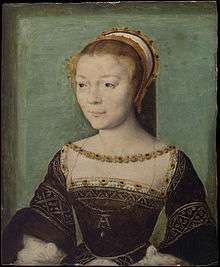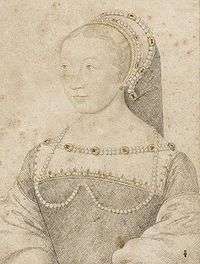Anne de Pisseleu d'Heilly
| Anne de Pisseleu d'Heilly | |
|---|---|
| Duchess of Étampes | |
 Portrait of Anne attributed to Corneille de Lyon (Metropolitan Museum of Art) | |
| Born | 1508 |
| Died | 1580 (aged 71–72) |
| Noble family |
Pisseleu d'Heilly (by birth) Brosse (by marriage) |
| Spouse(s) | Jean IV de Brosse |
| Father | Adrien de Pisseleu, seigneur d'Heilly |
| Mother | Charlotte d'Ailly |
Anna Jeanne de Pisseleu d'Heilly, Duchess of Étampes (1508 – 1580), was a chief mistress of Francis I of France.
She was a daughter of Adrien de Pisseleu, seigneur d'Heilly, a nobleman of Picardy, who, with the rise of his daughter at court, was made seigneur of Meudon, Master of waters and forests of Île de France, of Champagne and of Brie.
King's mistress
She came to court before 1522 and was one of the maids-of-honour of Louise of Savoy, Duchess of Angoulême, the mother of Francis I.[1] Francis made Anne his mistress, probably upon his return from his captivity at Madrid (1526), and soon gave up his long-term mistress, Françoise de Foix, for her.[2]
Anne was described as being sprightly, pretty, witty and cultured, "the most beautiful among the learned and the most learned among the beautiful"; she succeeded in keeping the favour of the king until his death in 1547. The liaison received some official recognition; when the new Queen of France, Eleanor of Austria, entered Paris in 1530, the King and Anne occupied the same window. In 1534, Francis gave her in marriage to Jean IV de Brosse, whom he created Duke of Étampes.[3][4]

The influence of the Duchess of Étampes, especially in the last years of the reign, was considerable.[3] She upheld Admiral Philippe de Chabot against the Constable de Montmorency, who was supported by her rival Diane de Poitiers, the dauphin's mistress. She was a friend to new ideas, tolerant of Protestants, whose beliefs she openly embraced after the King's death. She cooperated with the King's sister, Marguerite de Navarre.[4]
She used her influence to elevate and enrich her family,[5] her uncle, Antoine Sanguin (d. 1559), being made Bishop of Orléans in 1533 and a cardinal in 1539;[5] her three brothers were made bishops[5] and two sisters were abbesses, the other sisters making great marriages. The accusations made against her of having allowed herself to be won over by Charles V, Holy Roman Emperor, and of playing the traitor in 1544 and in the lead-up to the Treaty of Crépy (September 1545) rest on no serious proof.[4]
Following Francis's death, Diane de Poitiers, mistress of Henry II of France, had the Duchess dismissed from the court, took over the majority of her possessions and made her a prisoner in the custody of her husband. Though her court favorites were humiliated in every way upon her dismissal, she was permitted to die in obscurity much later, probably in the reign of Henry III.[4]
Notes
- ↑ Knecht 1994, p. 249.
- ↑ Wellman 2013, p. 143-144.
- 1 2 Knecht 1994, p. 290.
- 1 2 3 4

- 1 2 3 Potter 1993, p. 136.
References
- Knecht, R.J. (1994). Renaissance Warrior and Patron: The Reign of Francis I. Cambridge University Press.
- Potter, David (1993). War and Government in the French Provinces. Cambridge University Press.
- Wellman, Kathleen (2013). Queens and Mistresses of Renaissance France. Yale University Press.